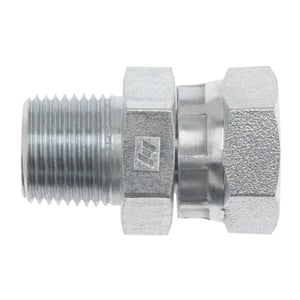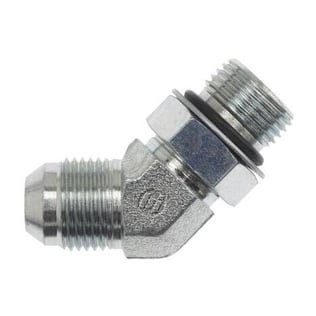Hydraulic fittings play a pivotal role in ensuring the smooth operation of a hydraulic hose system, and stainless steel ranks among the most prevalent materials used in a variety of systems. Stainless steel hydraulic fittings are primarily used where the internal media or the external environment is corrosive, offering outstanding durability, strength and safety.
Durability and strength
 Stainless steel is known for being very strong and durable when introduced to extreme-duty applications. The composition of the material allows stainless steel to become temperature resistant, which means it is safe to be used in high-temperature applications of up to 1112°F (600°C). However, most hydraulic hoses are only rated up to 212°F (100°C). Depending on the type of elastomeric material and number of spiral or braided wires, some specialty hoses can withstand up to 300°F (149°C)-- which is still well below the threshold of the fitting itself. However, there a certain specialty hose sleeves rated for 500°F (260°C) under continuous exposure and 2000°F (1093°C) for 15 to 20 minute intervals and even as high as 3000°F (1650°C) for limited exposure of up to 30 seconds.
Stainless steel is known for being very strong and durable when introduced to extreme-duty applications. The composition of the material allows stainless steel to become temperature resistant, which means it is safe to be used in high-temperature applications of up to 1112°F (600°C). However, most hydraulic hoses are only rated up to 212°F (100°C). Depending on the type of elastomeric material and number of spiral or braided wires, some specialty hoses can withstand up to 300°F (149°C)-- which is still well below the threshold of the fitting itself. However, there a certain specialty hose sleeves rated for 500°F (260°C) under continuous exposure and 2000°F (1093°C) for 15 to 20 minute intervals and even as high as 3000°F (1650°C) for limited exposure of up to 30 seconds. These temperature-resistant properties allow stainless steel fittings along with proper hose selection and/or hose protection to be used in a broad range of industries and applications, including but not limited to:
|
|
|
|
|
|
|
|
Among other benefits, stainless steel excels by being corrosion resistant. In particular environments, stainless steel is one of the most robust materials compared to others such as carbon steel or brass. This is especially beneficial for the oil & gas, marine and construction industries for example, as their numerous applications demand resilience in harsh environments.
Reliability and longevity at high pressures
Stainless steel is one of the most reliable materials for hydraulic hose fitting applications. Its composition allows the material to last more than 50 years. Stainless steel not only offers a long service life and dependable performance, but also stands up to wear and tear without compromising the integrity of applications. Although stainless-steel fittings are often rated up to 10,000 psi, one must be careful in hose selection. There are multiple pressure classifications in the ISO 18752 Standard for maximum hydraulic hose working pressure, which ranges from 500 to 8,000 psi, although there are many specialty hoses that can withstand 10,000 psi or above.
Low maintenance
Oftentimes, stainless steel fittings are valued for their low maintenance qualities in applications with high temperature or corrosive conditions, reducing system downtime in industries where a consistent and steady output is needed.
downtime in industries where a consistent and steady output is needed.
 downtime in industries where a consistent and steady output is needed.
downtime in industries where a consistent and steady output is needed.Additionally, stainless steel hydraulic hose fittings do not require an additional coating. While coatings can enhance the performance of alternative materials such as carbon steel, it is not required on stainless steel. This characteristic makes stainless steel fittings low maintenance compared to other materials, particularly since some other types of fittings may require recoating to extend their service life after installation.
Conclusion
Stainless steel hose fittings are an excellent choice for your hydraulic applications. They offer durability and strength, boasting qualities like resistance to temperature variations and corrosion. These attributes prove especially advantageous in industries where applications face incredibly harsh environments.
Furthermore, this material can provide more than 50 years of service when appropriately maintained. Notably, it requires minimal maintenance, meaning stainless steel hose fittings can endure wear and tear, surpassing the 50-year mark. Though again, one must be cognizant of the hose, as most hydraulic hoses only last 5 to 10 years. Note: In applications which cause the hose to flex repeatedly, such as backhoes or industrial hydraulic presses, hoses can deteriorate faster.
Compared to alternative materials, stainless steel hydraulic hose fittings efficiently combine strength, durability, reliability and longevity, all while enhancing leak-free performance as a low-maintenance solution.
Sources include:

